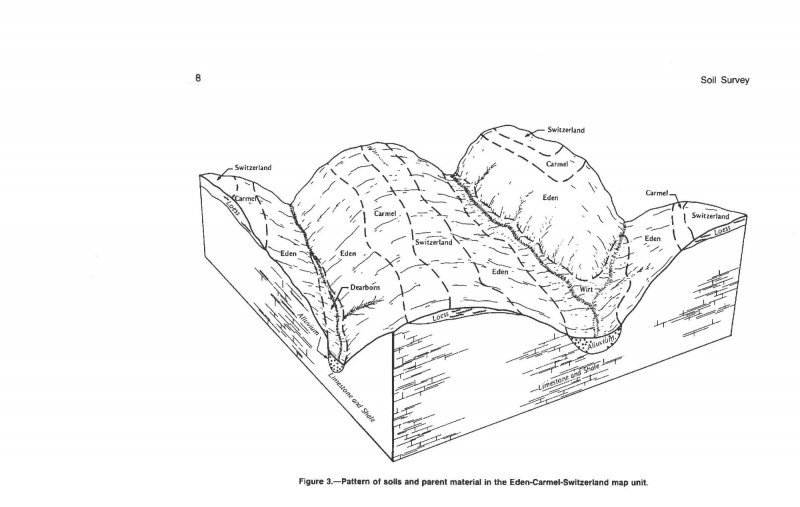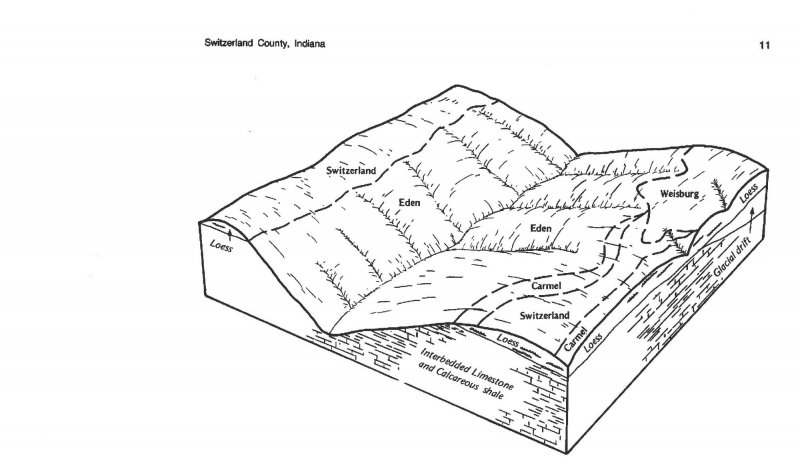
Natural Resources
Conservation Service
Ecological site F114XA305IN
Non-Acidic Upland Forest
Accessed: 12/22/2025
General information
Provisional. A provisional ecological site description has undergone quality control and quality assurance review. It contains a working state and transition model and enough information to identify the ecological site.
MLRA notes
Major Land Resource Area (MLRA): 114X–Southern Illinois and Indiana Thin Loess and Till Plain
MLRA 114A makes up about 4,550 square miles (11,795 square kilometers). The three parts of this MRLA are mostly in the Till Plains Section of the Central Lowland Province of the Interior Plains. The western third of the western part is in the Highland Rim Section of the Interior Low Plateaus Province of the Interior Plains. The eastern half of the eastern part is in the Kanawha Section of the Appalachian Plateaus Province of the Appalachian Highlands. Both large and small tributaries of the Ohio River dissect the nearly level to very steep glaciated uplands in this area. The major streams and rivers have well defined valleys with broad flood plains and numerous stream terraces. The flood plains along the smaller streams are narrow. Broad summits are nearly level to gently sloping. Elevation ranges from 320 feet (100 meters) on the southernmost flood plain along the Ohio River to 1,250 feet (380 meters) on the highest ridges. Local relief is mainly 10 to 50 feet (3 to 15 meters), but it can be 50 to 100 feet (15 to 30 meters) along drainageways and streams. Also, the Ohio River bluffs are as much as 300 feet (90 meters) above the river valley floor.
Classification relationships
USFS: 222 Eastern Broadleaf Forest (Continental) Province
Homoya's Natural Regions of Indiana: Bluegrass Region
The following NatureServe Explorer Ecological System Record(s) have a high level of probability to match the ecological site reference community found on these soils.
Scientific Name: Southern Interior Low Plateau Dry-Mesic Oak Forest- Unique Identifier: CES202.898
Ecological site concept
Non-Acidic Upland Forest sites were historically old-growth upland oak-hickory forests with a high level of canopy, shrub and understory diversity. Oak and hickory species exhibit dominance on these sites along with a robust native plant herbaceous layer. Multiple oak and hickory species may be present on these sites depending on available water, aspect, disturbance history, and seed sources. Oak species found on sites include white oak (Quercus alba), northern red oak (Q. rubra), Shumard oak (Q. shumardii), black oak (Q. velutina), and on drier or shallower sites, chinkapin oak (Q. muehlenbergii) or scarlet oak (Q. coccinea). Hickory species common to these sites include shagbark hickory (Carya ovata), mockernut hickory (C. tomentosa, C. alba), and bitternut hickory (C. tomentosa).
Other hardwoods in the canopy may include black walnut (Juglans nigra), American elm (Ulmus americana), white ash (Fraxinus alba), and sugar maple (Acer saccharum). Mid-canopy constituents include eastern redbud (Cercis canadensis), flowering dogwood (Cornus florida), blue ash (Fraxinus quadrangulata), slippery elm (Ulmus alata), eastern red cedar (Juniperous virginiana) and hophornbeam (Ostrya virginiana). Due to changes in the natural fire regime and historic disturbances (logging, grazing) sites are now often mid-age hardwood stands that have a predominance of tulip poplar, sugar maple, white ash, boxelder, and red maple.
Associated sites
| F114XA502IN |
Till Uplands Till Upland forest. Sites with hardwood forests on till plains. |
|---|---|
| F114XA504IN |
Sloping Till Upland Forest Sloping Till Upland Forest. Sites with hardwood forests on sloping till soils. |
Similar sites
| F114XA302IN |
Acidic Upland Forest Acidic Upland Forest. These sites also exhibit a oak-hickory forest, but the dominant species will be those that prefer acidic soils. |
|---|
Table 1. Dominant plant species
| Tree |
(1) Quercus alba |
|---|---|
| Shrub |
(1) Cercis canadensis |
| Herbaceous |
(1) Jeffersonia diphylla |
Click on box and path labels to scroll to the respective text.


